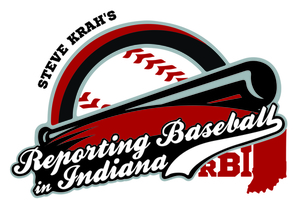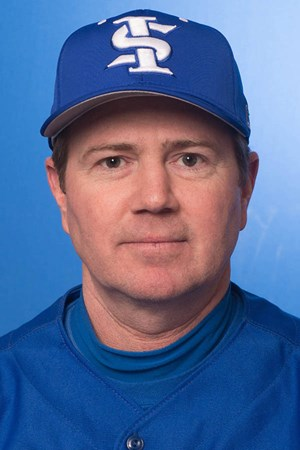
By STEVE KRAH
Indiana State University opens its 2019 baseball season with a three-game series Feb. 15-17 at Jacksonville (Fla.) University.
Fifth-year Sycamores pitching coach Jordan Tiegs is getting ISU arms ready for the opener and beyond.
“We’re full-go,” says Tiegs. “We’re building guys now. Some are up to four innings. We’d like our starters to be able to go six innings that first weekend.”
The process has been happening with both both scrimmages and bullpen sessions. They train with overload and underload throwing balls.
“We want to get it as close to what it’s like during the season as possible,” says Tiegs. Pitchers generally pitch live in intrasquad games on Friday, Saturday and Sunday while there is more bullpen work on Monday through Thursday.
ISU’s online roster lists 17 pitchers. All three of the team’s weekend starters from 2018 when the Sycamores went 31-24 overall and 11-10 in the Missouri Valley Conference — senior left-hander Triston Polley (Brownsburg High School graduate), senior right-hander Tyler Ward (Heritage Hills) and junior left-hander Tristan Weaver — return.
Polley went 7-2, Ward 6-3 and Weaver 3-5 in 2018.
Redshirt junior right-hander Colin Liberatore, who pitched at the University of Pittsburgh in 2016, is in the starting mix. Weekday starter Weston Rivers is not back.
While primary closer Ethan Larrison (25 appearances with nine saves) has moved on to professional baseball, 6-foot-5 junior left-hander Tyler Grauer (21 appearances with three saves) did some closing in 2018 and he’s back.
“We lost a lot of leads in sixth and seventh innings last year,” says Tiegs. “That will be a big emphasis this year.”
New pieces in the bullpen include right-handers Austin Cross, Zach Frey, Ross Kramer and Jake Ridgway and lefty Geremy Guerrero.
Cross, a 6-7 junior, is one of seven pitchers on the staff who were in junior college last season.
Tiegs calls junior Frey, also a JC transfer, a “competitive bulldog” who throws strikes.
Coming to Indiana State as a two-way player as a JC transfer, the Sycamores have decided to let junior Kramer focus on pitching.
“He may have the best arm on the staff,” says Tiegs.
Sophomore Ridgway impressed ISU coaches during a showcase camp and was made a full-time pitcher as a freshman.
Junior Guerrero is considered a “swing” man who could be used as a starter or in long or short relief.
Being tall with long limbs is helpful for a pitcher.
But size is not always the determining factor in success.
“In a perfect world, they could all be 6-3 and 215 (the average size of a big league starter),” says Tiegs. “But what about the 5-9 guy who throws in the low to mid 90’s and can really spin it and is really competitive?.
“We have a bit of a mix here,” says Tiegs, who has 6-9 junior left-hander Will Buraconak and 5-9 freshman righty Paul Wendling in the pitching corps. “Both are going to help us a lot.”
Of course the plan on paper in February is not always what unfolds by May.
But one thing is constant.
“We want guys who are going to compete for the right reasons and execute their game plan,” says Tiegs of his pitchers. “We want to generate as much weak contact as we can.
“For some guys play book is simple. For some, it’s more complicated. It’s what they can handle.”
When recruiting, Tiegs wants pitchers who have a feel for the game around them and not ones who “can win the 60-foot, 6-inch battle” only.
“These are the ones who can’t hold runners and can’t field their positions,” says Tiegs. “Guys don’t work on these days as much as they used to.
“You can forget that a whole game is being played.”
Tiegs works for Sycamores head coach Mitch Hannahs.
“He’s a very smart baseball guy,” says Tiegs of Hannahs. “He knows what pitching means to a team. It can make or break your entire season.”
Hannahs gives his perspective while giving Tiegs the freedom to develop his staff his way.
“As a former infielder, he has a pretty good feel for what pitchers go through on the mental side,” says Tiegs.
The mental side of the game is something that is addressed daily by Tiegs in practice.
“We get them in the right frame of mind on the mind,” says Tiegs. “We want them to be in control of their thoughts and in the moment.
“They should keep things as simple as possible and not get the wheels spinning too much.”
Speaking of spinning, Indiana State does keep tabs on spin rate, spin axis and rotation using Rapsodo technology.
Tiegs notes that the use of TrackMan is another way of getting analytic feedback.
This can help players “develop a better version of themselves.”
“We don’t want to overkill with it,” says Tiegs. “It’s just another tool.”
Tiegs is a 2005 graduate of Huron Park Secondary School in Woodstock, Ontario, Canada.
There was no high school baseball in his district. But he played on an elite travel team. The London Badgers played about 80 games a year from April to September with three or four tournaments in the U.S.
Tiegs also participated in volleyball, basketball, hockey and tennis and is definitely a believer in the concept of the multi-sport athlete.
“It can hurt your athletic growth if you eliminate things at a younger age,” says Tiegs. “Using different movements, it’s only going to help in baseball with agility and coordination.
“The more you can be exposed to that stuff is only going to benefit you. You’re going to get enough isolated work when you get to college.”
Tiegs wants his pitchers to be as athletic as possible.
“Pitchers can get a bad rap at being the non-athletes on the field,” says Tiegs, who has his ISU hurlers go through circuit training — strength and mobility — each day before they ever throw a baseball.
Tiegs was a pitcher and was selected selected in the 46th round of the 2006 Major League Baseball Draft by the Cincinnati Reds, but played opted instead for college baseball. He played at Sauk Valley Community College in Dixon, Ill., the College of Charleston in South Carolina and wound up at the University of Indianapolis.
The head coach at Sauk Valley was Al Ready, who is now head coach at UIndy.
Keith Hatfield, now head coach at Center Grove High School, was his pitching coach at UIndy.
“In 2009, we had a lot of talent on the mound,” says Tiegs. “We had to make sure guys were in the zone with their stuff. The only way we were going to get beat was with free bases.”
Tiegs delivers the same message to the Sycamores.
“We want our guys to constantly apply pressure and the pressure will be on them,” says Tiegs.
Before coming to ISU, Tiegs was the U of I Greyhounds pitching coach for three seasons on the staff of head coach Gary Vaught.
Having played and coached at the two levels, what is the main difference in NCAA Division I and II from a pitching perspective?
“It’s in the depth of lineups you see day in and day out,” says Tiegs. “You can get away with more mistakes (in D-II). With the better D-I teams, you need to be sharp for 7, 8, 9 guys in lineup. When they hit your mistakes, it’s usually louder.”
Jordan and wife Chelsea Tiegs are expecting their first child in late March.
In its preseason poll, Missouri Valley Conference head coaches have picked Indiana State to finish third behind Missouri State and Dallas Baptist and ahead of Bradley, Southern Illinois, Illinois State, Valparaiso and Evansville.

Jordan Tiegs was a player and pitching coach at the University of Indianapolis before going to Indiana State University as pitching coach. (University of Indianapolis Photo)

Jordan Tiegs is the baseball pitching coach at Indiana State University in Terre Haute, Ind. (Indiana State University Photo)

